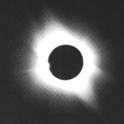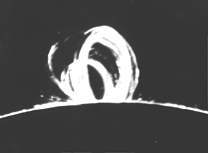|
黒点の上空のコロナの構造は、やはり磁力線に沿った
アーチのような馬蹄形の輪郭をしていることがよくあります。
そのアーチの頂上あたりから、
まるで飴菓子を引っ張って伸ばしたような長い筋状のものが、
太陽半径かそれより遠くの距離まで伸びていることもあります。
あたかも、何か(実は太陽風)がアーチの頂上から宇宙空間へと
物質を引っ張り出して行くように見えます。
天文学者はこの構造を「ヘルメット(兜型の)ストリーマー(吹き流し)」
と呼んでいます。西洋の騎士がかぶっていた、頭頂部のとがった兜(かぶと)に形が似ているためです。
(1918年ころまでドイツ兵などがかぶっていたヘルメットもそんな形なのだそうです。)
Structures observed in the corona above sunspots often have
horseshoe-shaped outlines, again suggesting that they follow magnetic
field lines. From the tops of such "arches" long streamers may extend, to
distances of the Sun's diameter or even more, looking like pulled taffy,
as if some process was pulling material away from the tops of the arches
into space, (which is of course what the solar
wind actually does). Astronomers have named them "helmet streamers"
because of their resemblance to spiked helmets worn by knights (and also
to those used by some German soldiers up to 1918).
高温のコロナ
The High Temperature of the Corona
コロナの最大の特徴は、温度が高いことです。
これはスウェーデンの天文学者Bengt Edlenが
コロナの光の研究の末、1942年に導き出した結論です。
コロナの光のほとんどは、コロナのダスト(塵)で散乱された太陽光にすぎませんでしたが、
ごく限られた色の範囲ながら、コロナ自身が出している光もありました。
(この限られた色の範囲のことを「スペクトル線」と呼びます。)
スペクトルの色は、光を出している原子の種類ごとに違います。
太陽光のスペクトル線の観測は19世紀に始まっていましたが、
コロナのスペクトル線のうちのいくつかは、当時
地球上で知られていたどの物質の出すスペクトル光とも違っていました。
そこでこの光を出しているのは、新種の未知の化学物質であろうと考えられ、
ギリシア語で「太陽」をあらわす言葉「ヘリオス」から、
「ヘリウム」と名づけられました。
Norman Ramseyが地球上にもヘリウムが存在することを発見したのは、
後の1985年のことでした。
The most remarkable aspect of
the corona is its high temperature, deduced by the Swedish astronomer
Bengt Edlen in 1942 after a study of the corona's light. Much of that is
sunlight scattered by coronal dust, but some light is also produced by the
corona itself, in narrowly defined colors ("spectral lines")
characteristic of its emitting atoms. In the 19th century, some of the
spectral lines of sunlight did not match the lines of any substance on
Earth, and it was proposed that they came from a new unknown chemical
element, named helium (from the Greek helios--Sun). Later,
in 1895, Norman Ramsey actually discovered helium on Earth.
コロナから放出される未知のスペクトル線は、ヘリウムと同様に、
「コロニウム」という新種の化学物質が出す光ではないかと考えられましたが、
Edlenは、そのスペクトル線が、鉄やニッケルやカルシウムという身近な原子から
電子をたくさん(鉄なら13-14個)剥ぎ取った場合に出る光であることを発見しました。
原子から電子が取れることを「電離」と呼びますが、
それほど高い電離状態(それほどどたくさんの電子が取れた状態)になるためには
原子が、100万度という高温になる必要があります。
Unknown spectral lines emitted by the corona were similarly credited to
a new element "coronium" until Edlen showed that they came from the
familiar atoms of iron, nickel and calcium, after they had lost an
appreciable number of electrons (e.g. 13 or 14 for iron). Such high levels
of ionization require the atoms to be buffeted around by extremely high
temperatures, around 1,000,000 C (1,800,000 F).
コロナの熱がどこから来ているのかはいまだに謎のままです。
熱い太陽の内部から来ていることは確かです。コロナ以外の太陽の熱も
そこから来ているはずです。しかし、温度と言うものは
熱い所から離れれば離れるほど下がって行くはずなのに、
100万度のコロナは、温度6千度以下の太陽表面よりもさらに遠くにあるのです。
The source of the corona's heat remains a puzzle. It is almost certain
that its energy comes from the Sun's internal furnace, which also supplies
the rest of the Sun's heat. However, as a rule, temperatures are expected
to drop the further one gets from the furnace, whereas the million-degree
corona lies outside the surface layer where sunlight originates,
whose temperature is less that 6000 C.
X線で見たコロナ
The Corona in X-ray Light
高温の物質は電磁波
を出します。たとえば、電球のフィラメントを熱すると光を出します。
物が熱くなればなるほど、光の波長は短くなります。
コロナが可視光線や紫外線よりもずっと波長の短いX線を出すのは
そのためです。
All hot objects emit electromagnetic
waves--for example, visible light is emitted by the hot filament
inside a lightbulb. The hotter the object, the shorter the wavelength,
which is why the corona emits "soft x rays," whose waves are much shorter
than those of visible or ultra-violet light.
|



 Official GSFC Home Page
Official GSFC Home Page  NASA WWW Home Page
NASA WWW Home Page